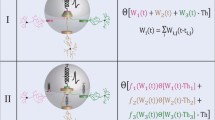Abstract
Single isolated neurons show a nonlinear increase in likelihood of firing in response to random input, when they are biased toward threshold by steady-state depolarization. It is postulated that this property holds for neurons in the olfactory bulb, a specialized form of cortex in which the steady state is under centrifugal control. A model for this non-linearity is based on two first order differential equations that interrelate three state variables: activity density in the pulse mode p of a local population (subset) of neurons; activity density in the wave mode u (mean dendritic current); and an intervening variable m that may be thought to represent the average subthreshold value in the subset for the sodium activation factor as defined in the Hodgkin-Huxley equations. A stable steady state condition is posited at (p 0, u 0, m 0). It is assumed that: (a) the nonlinearity is static; (b) m increases exponentially with u; (c) p approaches a maximum p m asymptotically as m increases; (d) p≧0; and (e) the steady state values of p 0, u 0, and m 0 are linearly proportional to each other. The model is tested and evaluated with data from unit and EEG recording in the olfactory bulb of anesthetized and waking animals. It has the following properties. (a) There is a small-signal near-linear input-output range. (b) There is bilateral saturation for large input, i.e. the gain defined as dp/du approaches zero for large |u|. (c) The asymptotes for large input±u are asymmetric. (d) The range of output is variable depending on u 0. (e) Most importantly, the maximal gain occurs for u>u 0, so that positive (excitatory) input increases the output and also the gain in a nonlinear manner. It is concluded that large numbers of neurons in the olfactory bulb of the waking animal are maintained in a sensitive nonlinear state, that corresponds to the domain of the subthreshold local response of single axons, as it is defined by Rushton and Hodgkin.
Similar content being viewed by others
References
Agin, D.: Hodgkin-Huxley equations: logarithmic relation between membrane current and frequency of repetitive activity. Nature 201, 625–626 (1964)
Baker, C.L.: Nonlinear systems analysis of computer models of repetitive firing. Biol. Cybernetics 29, 115–123 (1978)
Calvin, W.H.: Generation of spike trains in CNS neurons. Brain Res. 84, 1–22 (1975)
Cooley, J.W., Dodge, F.A., Jr.: Digital computer solutions for excitation and propagation of the nerve impulse. Biophys. J. 6, 583–599 (1966)
Dodge, F.A., Jr.: On the transduction of visual, mechanical, and chemical stimuli. Int. J. Neurosci. 3, 5–14 (1972)
Fohlmeister, J.F., Poppele, R.E., Purple, R.L.: Repetitive firing: dynamic behavior of sensory neurons reconciled with a quantitative model. J. Neurophysiol. 37, 1213–1227 (1974)
Freeman, W.J.: Mass action in the nervous system. New York: Academic Press 1975
Freeman, W.J.: Spatial properties of an EEG event in the olfactory bulb and cortex. Electroencephalogr. Clin. Neurophysiol. 44, 586–605 (1978)
Granit, R., Kernell, D., Shortess, G.K.: Quantitative aspects of repetitive firing of mammalian motoneurons caused by injected currents. J. Physiol. 168, 911–931 (1963)
Heyer, C.B., Llinás, R.: Control of rhythmic firing in normal and axotomized cat spinal motoneurons. J. Neurophysiol. 40, 480–488 (1976)
Hodgkin, A.L.: The subthreshold potentials in a crustacean nerve fibre. Proc. R. Soc. London, Ser. B 126, 87–121 (1938)
Hodgkin, A.L.: The conduction of the nervous impulse. Liverpool: University Liverpool Press 1964
Katz, B.: Electric excitation of nerve. Oxford: Oxford University Press 1940
Rinzel, J.: On repetitive activity in nerve. Fed. Proc. 37, 2793–2802 (1978)
Rushton, W.A.H.: Initiation of the propagated disturbance. Proc. R. Soc. London, Ser. B 124, 210–243 (1937)
Stein, R.B.: The frequency of nerve action potentials generated by applied currents. Proc. R. Soc. London, Ser. B 167, 64–86 (1967)
Sunday, D.M., Freeman, W.J.: Nonlinear coupling of wave and pulse activity in a neural mass. Physiologist 18, 42 (1975)
Author information
Authors and Affiliations
Additional information
Supported by a grant MH 06686 from the National Institute of Mental Health, and by a Research Professorship from the Miller Institute
Rights and permissions
About this article
Cite this article
Freeman, W.J. Nonlinear gain mediating cortical stimulus-response relations. Biol. Cybernetics 33, 237–247 (1979). https://doi.org/10.1007/BF00337412
Received:
Issue Date:
DOI: https://doi.org/10.1007/BF00337412




